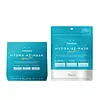What's inside
What's inside
 Key Ingredients
Key Ingredients

 Benefits
Benefits

 Concerns
Concerns

 Ingredients Side-by-side
Ingredients Side-by-side

Water
Skin ConditioningButylene Glycol
HumectantDipropylene Glycol
HumectantGlycerin
HumectantOryza Sativa Bran Extract
Skin ConditioningRice Ferment Filtrate
Skin ConditioningCentella Asiatica Leaf Extract
Skin ConditioningHouttuynia Cordata Extract
Skin ConditioningDisodium EDTA
Acrylates/C10-30 Alkyl Acrylate Crosspolymer
Emulsion StabilisingPEG-50 Hydrogenated Castor Oil Isostearate
EmulsifyingIsotridecyl Isononanoate
EmollientCarbomer
Emulsion StabilisingTriethylhexanoin
MaskingMalic Acid
BufferingSodium Hydroxide
BufferingPhenoxyethanol
PreservativeParfum
MaskingWater, Butylene Glycol, Dipropylene Glycol, Glycerin, Oryza Sativa Bran Extract, Rice Ferment Filtrate, Centella Asiatica Leaf Extract, Houttuynia Cordata Extract, Disodium EDTA, Acrylates/C10-30 Alkyl Acrylate Crosspolymer, PEG-50 Hydrogenated Castor Oil Isostearate, Isotridecyl Isononanoate, Carbomer, Triethylhexanoin, Malic Acid, Sodium Hydroxide, Phenoxyethanol, Parfum
Water
Skin ConditioningGlycerin
HumectantButylene Glycol
HumectantNiacinamide
SmoothingPotassium Azeloyl Diglycinate
Skin ConditioningMandelic Acid
AntimicrobialHydrolyzed Sodium Hyaluronate
Skin ConditioningBifida Ferment Filtrate
Skin ConditioningLactobacillus/Pear Juice Ferment Filtrate
Skin ConditioningRaffinose
Skin ConditioningPEG-40 Hydrogenated Castor Oil
EmulsifyingXanthan Gum
EmulsifyingCitric Acid
BufferingSodium Citrate
BufferingDisodium EDTA
Carbomer
Emulsion StabilisingPotassium Hydroxide
BufferingPhenoxyethanol
PreservativeMethylparaben
PreservativeWater, Glycerin, Butylene Glycol, Niacinamide, Potassium Azeloyl Diglycinate, Mandelic Acid, Hydrolyzed Sodium Hyaluronate, Bifida Ferment Filtrate, Lactobacillus/Pear Juice Ferment Filtrate, Raffinose, PEG-40 Hydrogenated Castor Oil, Xanthan Gum, Citric Acid, Sodium Citrate, Disodium EDTA, Carbomer, Potassium Hydroxide, Phenoxyethanol, Methylparaben
Ingredients Explained
These ingredients are found in both products.
Ingredients higher up in an ingredient list are typically present in a larger amount.
Butylene Glycol (or BG) is used within cosmetic products for a few different reasons:
Overall, Butylene Glycol is a safe and well-rounded ingredient that works well with other ingredients.
Though this ingredient works well with most skin types, some people with sensitive skin may experience a reaction such as allergic rashes, closed comedones, or itchiness.
Learn more about Butylene GlycolCarbomer is a polymer of acrylic acid. Its main role is to create a gel consistency.
A high amount of carbomer can cause pilling or balling up of products. Don't worry, most products contain 1% or less of carbomer.
Disodium EDTA plays a role in making products more stable by aiding other preservatives.
It is a chelating agent, meaning it neutralizes metal ions that may be found in a product.
Disodium EDTA is a salt of edetic acid and is found to be safe in cosmetic ingredients.
Learn more about Disodium EDTAGlycerin is already naturally found in your skin. It helps moisturize and protect your skin.
A study from 2016 found glycerin to be more effective as a humectant than AHAs and hyaluronic acid.
As a humectant, it helps the skin stay hydrated by pulling moisture to your skin. The low molecular weight of glycerin allows it to pull moisture into the deeper layers of your skin.
Hydrated skin improves your skin barrier; Your skin barrier helps protect against irritants and bacteria.
Glycerin has also been found to have antimicrobial and antiviral properties. Due to these properties, glycerin is often used in wound and burn treatments.
In cosmetics, glycerin is usually derived from plants such as soybean or palm. However, it can also be sourced from animals, such as tallow or animal fat.
This ingredient is organic, colorless, odorless, and non-toxic.
Glycerin is the name for this ingredient in American English. British English uses Glycerol/Glycerine.
Learn more about GlycerinPhenoxyethanol is a preservative that has germicide, antimicrobial, and aromatic properties. Studies show that phenoxyethanol can prevent microbial growth. By itself, it has a scent that is similar to that of a rose.
It's often used in formulations along with Caprylyl Glycol to preserve the shelf life of products.
Water. It's the most common cosmetic ingredient of all. You'll usually see it at the top of ingredient lists, meaning that it makes up the largest part of the product.
So why is it so popular? Water most often acts as a solvent - this means that it helps dissolve other ingredients into the formulation.
You'll also recognize water as that liquid we all need to stay alive. If you see this, drink a glass of water. Stay hydrated!
Learn more about Water